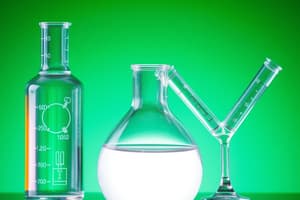Podcast
Questions and Answers
What is the primary reason why increasing the concentration of reactants in a solution increases the rate of reaction?
What is the primary reason why increasing the concentration of reactants in a solution increases the rate of reaction?
- It reduces the formation of intermediate compounds
- It changes the binding sites of enzymes
- It decreases the activation energy of the reaction
- It increases the number of collisions between reactants (correct)
How do enzymes increase the rate of reaction?
How do enzymes increase the rate of reaction?
- By forming intermediate compounds with reactants
- By increasing the activation energy of the reaction
- By decreasing the concentration of reactants
- By taking reactants out of dilute solution and holding them close to each other (correct)
What is the role of the catalyst in the intermediate formation theory of catalysis?
What is the role of the catalyst in the intermediate formation theory of catalysis?
- It decreases the rate of reaction
- It increases the concentration of reactants
- It forms intermediate compounds with reactants (correct)
- It reduces the activation energy of the reaction
Why are intermediate compounds formed in the intermediate formation theory of catalysis?
Why are intermediate compounds formed in the intermediate formation theory of catalysis?
What is a characteristic of the intermediate compound formed in the intermediate formation theory of catalysis?
What is a characteristic of the intermediate compound formed in the intermediate formation theory of catalysis?
Why are reactions involving catalysts faster than uncatalyzed reactions?
Why are reactions involving catalysts faster than uncatalyzed reactions?
What is the typical reaction scheme represented in the given equation?
What is the typical reaction scheme represented in the given equation?
What is the characteristic of heterogeneous catalysts?
What is the characteristic of heterogeneous catalysts?
What is the role of the substrate in industrial applications of heterogeneous catalysts?
What is the role of the substrate in industrial applications of heterogeneous catalysts?
What is the process by which the reactants are adsorbed onto the surface of the catalyst?
What is the process by which the reactants are adsorbed onto the surface of the catalyst?
What is the characteristic of a good catalyst?
What is the characteristic of a good catalyst?
What is the term for the phenomenon where one of the products acts as a catalyst?
What is the term for the phenomenon where one of the products acts as a catalyst?
Flashcards are hidden until you start studying
Study Notes
Factors Affecting Reaction Rates
- Proximity of reactants increases reaction rates, as it increases the number of collisions between reactants
- Enzymes work by binding reactants, increasing their effective concentration and leading to increased reaction rates
The Intermediate Formation Theory of Catalysis
- Catalysts form intermediate compounds with reactants, which then react to form products
- Intermediate compounds are unstable and break down to release products and the original catalyst
- This process is faster than the uncatalyzed reaction
Reaction Scheme
- X + C → XC (1)
- XC + Y → XYC (2)
- XYC → CZ (3)
- CZ → C + Z (4)
Heterogeneous Catalysis
- Catalyst and reactants are in different phases (e.g., solid catalyst, liquid or gas reactants)
- Catalyst is often supported on a substrate to increase surface area and stability
- Reactants adsorb onto the catalyst surface, migrate, react, and then desorb as products
Autocatalysis
- One of the products acts as a catalyst, increasing the reaction rate over time
- Examples include the oxidation of oxalic acid by acidified potassium permanganate and the reaction between nitric acid and copper
Studying That Suits You
Use AI to generate personalized quizzes and flashcards to suit your learning preferences.




